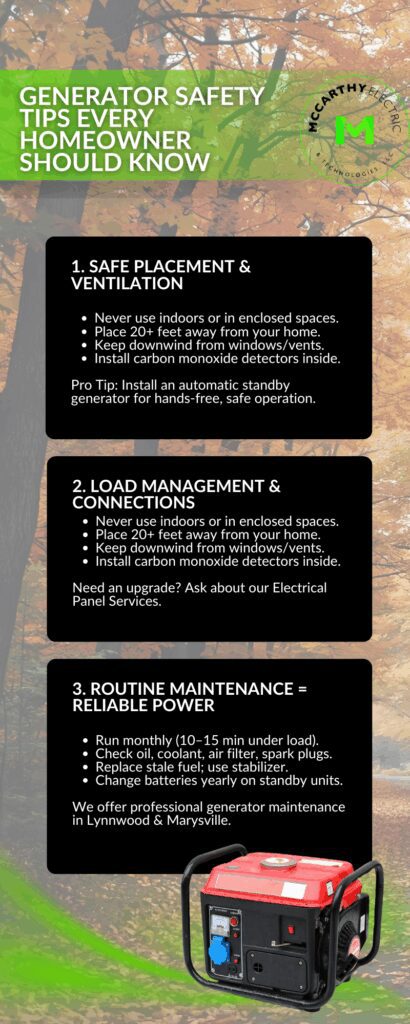Generators Can Be Lifesavers — But Only If Used Safely
When the power goes out, your generator becomes the unsung hero of your home. But without proper safety precautions, that same equipment can become a serious hazard.
Whether you’ve already installed a backup generator or are considering one, knowing how to operate it safely could be the difference between comfort and catastrophe. At McCarthy Electric, we help homeowners across Lynnwood, Marysville, and beyond stay prepared — and safe — with professional installation and safety inspections.
In this guide, we’ll break down the essential generator safety tips every homeowner should know to protect their property and their family.
Placement & Ventilation Safety
Never Use Generators Indoors or in Enclosed Spaces
Running generators in garages, basements, or near open windows releases deadly carbon monoxide — an invisible, odorless gas that claims hundreds of lives each year.
Best Practices:
- Always place your generator at least 20 feet away from your home, outside.
- Keep it downwind from windows, doors, and vents.
- Never operate your generator in a carport, shed, or enclosed patio.
- Install CO detectors inside your home if you use a portable generator.
Pro Tip: Want peace of mind? Consider installing an automatic standby generator that kicks in safely when the power goes out. Learn about our Generator Installation Services
Proper Load Management & Connections
Don’t Overload Your Generator
Overloading your generator can cause overheating, damage to your appliances, or even start a fire.
Key Tips:
- Know your generator’s wattage limit. Add up the wattage of all appliances you plan to power.
- Only connect essential appliances — such as lights, refrigerator, and sump pump.
- Use a transfer switch for permanent setups. It prevents backfeeding, which can endanger utility workers and damage your electrical panel.
“McCarthy Electric installed our standby generator and took the time to explain everything — from load limits to transfer switch safety. They were professional, honest, and made sure our home was protected the right way.”
— Lexie Manzanares, Lake Stevens
Check what our clients say about us
Want to be sure your panel can handle generator power? Schedule an Electrical Panel Upgrade

Generator Maintenance 101
Routine Care = Reliable Backup Power
Just like your car, your generator requires regular checkups to operate safely and efficiently.
Monthly Maintenance Checklist:
- Run the generator for 10–15 minutes (test under load if possible)
- Check oil and coolant levels.
- Inspect air filters and spark plugs.
- Replace stale fuel — use a fuel stabilizer if storing it for long-term use.
- Replace batteries on standby generators annually.
Our certified technicians provide generator maintenance services in Lynnwood and Marysville, ensuring your backup power is reliable when you need it most.
Emergency Safety Gear & Accessories
Equip Your Home for Safe Generator Use
It’s not just about the generator — the accessories and environment matter too.
Safety Must-Haves:
- Heavy-duty outdoor-rated extension cords
- Class C fire extinguisher nearby
- Carbon monoxide detectors on every floor
- Battery-powered lights in case of generator failure
- Whole-home surge protection to protect sensitive electronics
Check out our Surge Protection Services
Cord Safety Tips:
- Never run cords under rugs or through windows
- Avoid overloading individual outlets.
- Uncoil cords entirely to prevent overheating.
Protect Your Family—Schedule a Generator Inspection Today
A generator is only as safe as the way it’s installed and maintained.
McCarthy Electric offers expert installation, panel integration, and safety inspections for homeowners across Snohomish County. Whether you live in Lynnwood, Marysville, or Lake Stevens, our licensed, insured, and Tesla-certified electricians are here to help.
“Certified Electricians. Quality Work. Guaranteed.”
FAQs About Generator Safety
Is it safe to use a portable generator in the garage if the door is open?
No. Even with the door open, carbon monoxide can build up quickly. Continuously operate generators at least 20 feet from any structure.
Can I plug my generator directly into a wall outlet?
Absolutely not. Plugging a generator into a wall outlet is known as backfeeding, which is a hazardous practice. You risk electrocuting utility workers and destroying your electrical system. Always use a transfer switch or hire a licensed electrician.
How often should I run my generator to keep it in good shape?
Run it at least once a month for 10–15 minutes. During that time, test it under load if possible to ensure everything functions properly.
Final Thoughts: Safety First, Power Always
Your generator should be a trusted ally — not a safety risk. Whether you’re preparing for storm season or live in a rural area with frequent outages, generator safety isn’t optional.
Let McCarthy Electric be your partner in protection. With over 25 years of experience, our team is available 24/7 to ensure your power comes back safely — no matter what.

